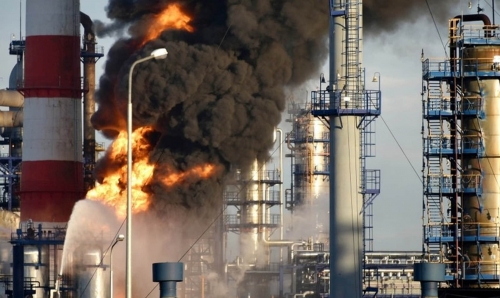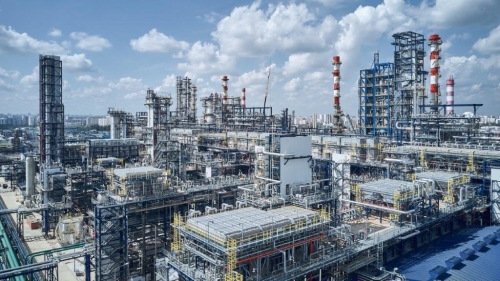Ahead of September’s monitoring meeting, OPEC remains between a rock and a hard place. Simon Watkins reports from London
The key parties in December’s deal by OPEC and non-OPEC producers to cut production by 1.2 million bpd and 0.6 million bpd respectively face a no-win situation when they meet on September 22.
“If they keep things as they are then the oil price will continue to gradually drift downwards. If they abandon the deal then the oil price would fall through the floor and inflict even more damage on their economies. While if they deepen production cuts then initial price increases would prompt even greater flows from the very people that they tried to destroy in 2014, the US shale drillers,” Sam Barden, CEO of Middle Eastern energy trading firm and consultancy SBI Markets, told NewsBase Intelligence (NBI).
“Factor into this the fact that the markets no longer believe a word any of them say, which means the days of trying to talk up prices are also long gone, and it’s a very bleak prospect indeed,” he added.
Weak hand
“The basic reason for the current strategic impasse facing the key OPEC and non-OPEC players is that the original deal had more holes in it than Swiss cheese,” Norbert Ruecker, head of macroeconomic and commodities research for Zurich-based Bank Julius Baer, told NBI.
“To begin with, before the deal was implemented many of the participants ramped up oil production so that the supposed cut in their output only took them back to their usual levels of output anyway,” he said.
Most notable in this respect, both from the empirical perspective of absolute output produced and from the moral viewpoint of setting the tone for the other participants in the deal, was the boost in production witnessed by the de facto leader of OPEC, Saudi Arabia.
From June of 2016, when preliminary discussions over a production cut began, Saudi started to increase its output dramatically. In November, just before the production cut was finally agreed and publically announced, Saudi ramped up output to its highest level ever, 10.72 million bpd, compared with an average from 1973 to that point of 8.04 million bpd.
“Also, there has been obvious and significant non-compliance from various OPEC members at various times since the deal was announced,” added Ruecker.
Indeed, having initially bewilderingly pretended that it misunderstood the deal, supposedly thinking it related to exports and not production, Iraq’s compliance slumped to just 29% in June, its lowest ever, according to the International Energy Agency (IEA).
Since then, Iraq has maintained that the baseline data that OPEC originally used in calculating the production limits underestimated actual production levels at the time and that it is consequently actually making the full reduction required.
In the meantime, non-OPEC Kazakhstan, rather than reducing its output as promised, has steadily increased it, with the relentless expansion of its Kashagan oilfield.
Exemptions and over-stocking
“Another huge hole in the deal was that there were extremely significant exemptions made for some major oil producing nations, including Iran, Nigeria and Libya,” Ruecker said.
Regardless of the reasons why these countries were exempted, at the time the deal was announced, Iran was already producing nearly 4 million bpd, with plans on track to hit at least 6 million bpd as soon as possible, Nigeria was nearing production of 1.8 million bpd, and Libya was producing around 650,000 bpd even as it was suffering from technical problems at its fields.
As it now stands, Iran achieved output of over 4 million bpd just after the deal was agreed and is still producing just under this figure, Nigeria’s output (including condensate) is up to 2.2-2.3 million bpd, according to government officials, and Libya’s production topped 1 million bpd recently.
Even based on these official figures, the OPEC-sponsored deal is way off achieving its target of reducing inventories down to the five-year average when the current extension expires in April, according to IEA data.
As it currently stands, oil stocks in industrialised nations are still well over 200 million barrels above the five-year average, according to the IEA.
These are just the official figures; unofficially, the situation is much worse.
“In reality, the Saudis are utilising their strategic oil stockpile to sell around 350,000 bpd into the spot market via investment banks, the so-called ‘dark inventory’. Meanwhile, the Russians are also selling at least as much directly to China also without declaring it, and they are supposedly the two leading participants in the deal,” a senior oil and gas industry analyst told NBI last week.
US bulls on parade
In the meantime, the US shale industry continues to go from strength to strength. Contrary to the widely held assumption at the beginning of 2014 that these shale producers needed oil prices of at least US$60 to US$90 per barrel to survive, depending on the reservoir, as it now stands many of them in the best locations require much lower pricing both to break even and make profits.
Advances in technology and restructuring of financing means that it now makes economic sense to increase drilling at US$50 per barrel in the core areas of Bakken and in the Permian Basin this number is even lower, Brian Lidsky, managing director of oil and gas information, transaction and advisory firm PLS, told NBI.
Pioneer Natural Resources, one of the most prolific drillers in the Permian Basin, now has a breakeven oil price of just US$20 per barrel, according to a recent comment from its senior vice president, Frank Hopkins. He added: “Even in a US$40 world, we are making good returns.”
Moreover, recent price moves over the US$50 level have allowed many of these shale producers to hedge future output exposure even out to the next 10 years, Robert Savage, CEO of multi-strategy hedge fund CC Track, told NBI.
As such, the rig count of US shale explorers has more than doubled in the past year, according to Baker Hughes, its strongest recovery in 30 years. These producers are boosting drilling budgets 10 times faster than the rest of the world to harvest fields that register large profits even at current price points.
Over, the EIA estimates that US crude production will surpass the 10 million bpd mark by late 2018, breaching the record high set in 1970, with the shale boom propelling non-OPEC output up by 1.3 million bpd, completely nullifying any OPEC cut.
Baseless optimism
Aside from the ongoing cheating over quotas, lying over secret deals, and failure to understand the competition, the apparent optimism of the OPEC and non-OPEC participants in the current deal is without foundation, as NBI understands there is no reason to believe that a re-balancing of the oil market will happen any time soon.
On the supply side, for example, China has made an offer to Venezuela that it will invest US$25 billion over the next three years in equipment and engineering that will lift its oil production by at least 55% over that period, which would bring it up to just over 3.4 million bpd.
Additionally, the move towards liberalising big domestic oil and gas markets to foreign investment will continue, opening up new supply at the end of this decade and into next in major producing countries such as Mexico, Brazil and Algeria, as they are already doing in Iran and Iraq, with sweetened new contracts.
“On the demand side, we are in one of the longest global economic growth expansions in history, so we can expect this to tail off in the coming years,” added Ruecker.
Indeed, the shorter-term business cycles – within the long-term ‘Kondratieff Wave’ economic cycles in global capitalist economies that last 45-60 years – typically persist for between three to five years from peak to peak, with the average duration of an expansion being nearly four years, according to data collected from 1857 to the present day by the US’s National Bureau of Economic Research. This would imply that the current expansion is already due for a correction.
Given this, it would appear that the only option available to the OPEC and non-OPEC participants in the current production cut deal is to save face, rather than effect any real change to the dynamics of the oil price, posits Ruecker.
“Trying to talk up the price won’t cut it anymore and nor will simply extending the current cuts, as these have been shown to be ineffective.
The only way the deal can be salvaged is to try to get the exempt countries to adhere to some production quotas at the next full OPEC meeting [November 30] and to extend the deal not just for another three or six months but for at least a year, and this might steady things for a while,” he concluded.
No easy solution as OPEC, NOPEC take stock
2017.09.19
1 181

%20(1).png)



